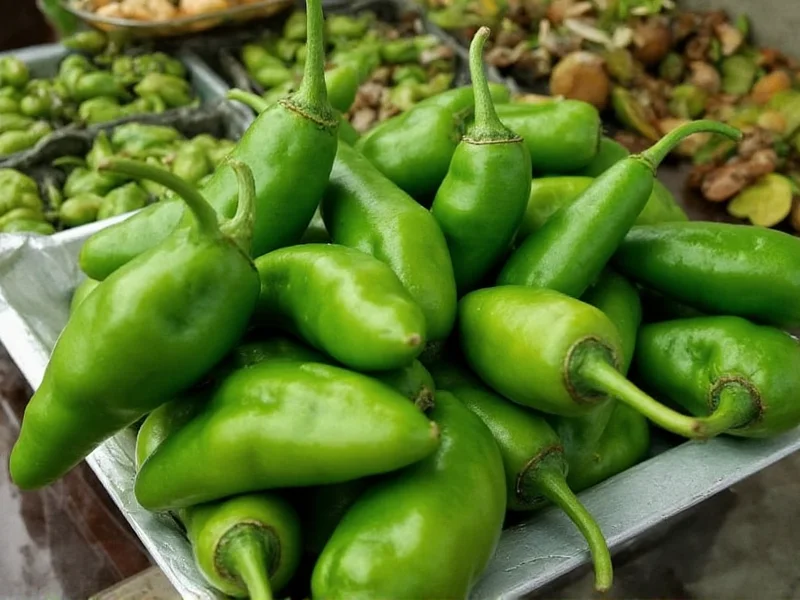Poblano peppers, scientifically classified as Capsicum annuum, deliver a subtle warmth that enhances dishes without dominating flavors. Understanding their heat profile helps home cooks and culinary professionals make informed decisions when selecting peppers for recipes. This comprehensive guide examines poblano heat levels, influencing factors, and practical culinary applications.
Understanding Poblano Pepper Heat
Native to Puebla, Mexico, poblano peppers mature from dark green to deep red (when dried, they're called ancho chiles). Their mild heat level makes them versatile for stuffing, roasting, and blending into sauces. The Scoville scale measures capsaicin concentration—the compound responsible for spiciness—with poblanos sitting at the lower end of the spectrum.
| Pepper Variety | Scoville Heat Units (SHU) | Heat Comparison |
|---|---|---|
| Poblano | 1,000–2,000 | Mild warmth, subtle kick |
| Jalapeño | 2,500–8,000 | 3–4x hotter than poblano |
| Serrano | 10,000–23,000 | 10x hotter than poblano |
| Bell Pepper | 0 | No heat |
Factors Influencing Poblano Heat Levels
Several variables affect how hot your poblano peppers might taste:
Growing Conditions
Environmental stressors like inconsistent watering, temperature fluctuations, and soil composition can increase capsaicin production. Poblanos grown in arid climates often develop slightly higher heat levels than those cultivated in controlled environments.
Ripeness Stage
Green poblanos (harvested early) tend to be milder than fully ripened red poblanos. As peppers mature, their capsaicin concentration typically increases. Dried red poblanos (anchos) develop richer, smokier flavors with marginally elevated heat.
Individual Variation
Like all chili peppers, poblanos exhibit natural variation. Two peppers from the same plant might differ in heat intensity. The placenta (white ribs inside the pepper) contains the highest capsaicin concentration—removing these reduces perceived heat significantly.
Culinary Applications of Poblano Peppers
Their mild heat profile makes poblanos ideal for dishes requiring subtle warmth without overpowering other ingredients. Common uses include:
- Chiles Rellenos: Stuffed with cheese or meat, then battered and fried
- Rajas con Crema: Sliced roasted poblanos in creamy sauce
- Mole Sauce Base: Blended with tomatoes, spices, and chocolate
- Enchilada Fillings: Combined with shredded chicken or cheese
- Guacamole Enhancement: Finely diced for gentle heat
When roasting poblanos, their thick walls blister beautifully while retaining structure—a key reason they're preferred for stuffing over thinner-walled varieties. The charring process also develops complex flavor compounds that complement their mild heat.
Substitutes for Poblano Peppers
If poblanos aren't available, consider these alternatives based on desired heat level:
- For similar mild heat: Cubanelle or Anaheim peppers (500–2,500 SHU)
- For slightly more heat: Pasilla peppers (1,000–2,500 SHU)
- For no heat: Green bell peppers (0 SHU)
- For authentic Mexican flavor: Ancho chiles (dried poblanos)
Remember that substitution effectiveness depends on your recipe's requirements. For stuffed pepper dishes, maintain similar wall thickness; for sauces, focus on matching heat profiles.
Handling Poblano Peppers Safely
Despite their mild reputation, follow these precautions:
- Wear gloves when handling multiple peppers or if you have sensitive skin
- Avoid touching your face, especially eyes, during preparation
- Remove seeds and white membranes to reduce heat intensity
- Rinse cutting boards thoroughly with soapy water after use
Contrary to popular belief, running water over peppers while cutting doesn't increase heat transfer—the capsaicin oil is hydrophobic. Instead, use vinegar-based solutions to neutralize residual oils on surfaces.
Common Misconceptions About Poblano Heat
Several myths persist about these versatile peppers:
- Myth: All poblanos taste identical
Reality: Significant variation occurs between plants and growing seasons - Myth: Red poblanos are always hotter than green
Reality: Ripeness affects flavor more than heat; some green specimens exceed red in SHU - Myth: Cooking eliminates heat
Reality: Heat compounds concentrate when liquids evaporate during cooking
Understanding these nuances helps manage expectations when working with poblano peppers in various culinary applications.
When Poblanos Might Taste Unexpectedly Hot
Occasionally, gardeners and cooks report unusually spicy poblanos. This typically occurs when:
- Plants experience drought stress during fruit development
- Peppers remain on the vine significantly past optimal harvest time
- Cross-pollination occurs with hotter pepper varieties
- Genetic mutation produces atypically hot specimens
If you encounter an unexpectedly hot poblano, balance the dish with dairy (sour cream, cheese), acid (lime juice), or sweetness (honey, fruit) to counteract the heat.
Frequently Asked Questions
How does poblano heat compare to jalapeño?
Poblanos are significantly milder than jalapeños, typically measuring 1,000-2,000 Scoville units compared to jalapeños' 2,500-8,000 units. A poblano generally delivers about one-fourth the heat of an average jalapeño, making it accessible for those sensitive to spice while still providing noticeable warmth.
Can you eat poblano peppers raw?
Yes, poblano peppers can be eaten raw and are commonly used in salads and salsas. Their thick walls provide a satisfying crunch, and their mild heat won't overwhelm other ingredients. Raw poblanos have a grassy, slightly bitter flavor that mellows when roasted or cooked.
Why are some poblano peppers hotter than others?
Natural variation in poblano heat comes from growing conditions (water stress increases capsaicin), ripeness stage, and genetic factors. Peppers from the same plant can vary in heat, and the placenta (white ribs) contains most capsaicin. Removing seeds and membranes reduces perceived heat significantly.
Do poblano peppers get hotter when cooked?
Cooking concentrates poblano heat as water evaporates, making the capsaicin more potent per bite. However, prolonged cooking can break down some capsaicin compounds. Roasting develops complex flavors that balance the heat, while blending raw poblanos into sauces distributes heat more evenly throughout the dish.











 浙公网安备
33010002000092号
浙公网安备
33010002000092号 浙B2-20120091-4
浙B2-20120091-4